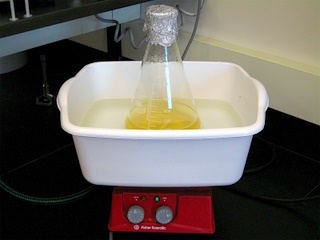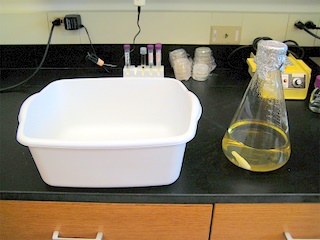Quick Water Immersion Cooling (QWIC)
NOTE: This technique works well at quickly cooling a solution uniformly and is utilized in our lab. It is not "scientifically proper," but it works well. Consult your professor first to see if this technique is appropriate for your lab.
Procedure
- You will need a thin, plastic container that will easily hold the appropriately sized flask. (Figure 1)
- Put water in it and immerse the flask in the water. The water level should be as high as, if not higher, than the level of the solution in the flask. (Figure 2)
- Next, place the container and flask on top of a stir plate and let it stir for 3-5 minutes or until it has reached the appropriate temperature. This allows for uniform cooling,
- The temperature can be approximated by placing your hand on the bottom of the flask and physically gauging the temperature. If you can hold your hand there for a decent amount of time, it is probably cool enough to add the remaining reagents. Remember, if it's too hot, the next reagents to be added will break down and not work. Conversely, if it cools too much, the agar will harden and you'll have to re-heat it to bring it back to its liquid form. Ask your professor for help if you are unsure of approximating the proper temperature.
- Once cool, remove the water tray.
Figures
Figure 1.
Choose an appropriately sized plastic container.
Figure 2.
Flask cooling in water, with stirring, to cool. This takes 3-5 minutes instead of 1 hour in the 56 degree C bath.



